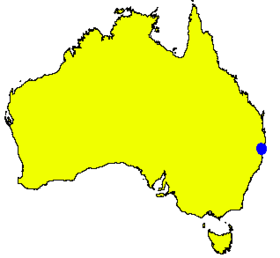Angophora robur
| Angophora robur | ||||||||||||
|---|---|---|---|---|---|---|---|---|---|---|---|---|
| Systematics | ||||||||||||
|
||||||||||||
| Scientific name | ||||||||||||
| Angophora robur | ||||||||||||
| LASJohnson & KDHill |

Angophora robur is a species ofthe myrtle family (Myrtaceae). It occurs around the town of Grafton in northeast New South Wales and is called "Sandstone Rough-barked Apple" there.
description
Appearance and leaf
Angophora robur grows as a tree that can reach heights of up to 10 meters. The bark remains on the entire tree, is gray or pale brown and has short fibers.
In Angophora robur is Heterophyllie ago. The simple leaves are always opposite to each other on the branches. The seated leaves on young specimens are narrowly elongated with a length of up to 10 cm and a width of about 2 cm; they have stiff, simple hair and bristly glandular hair ( trichomes ). On medium-aged specimens, the leaves are straight, entire and dull green. The leaves on adult specimens are divided into petiole and leaf blade. Your petiole is - if available - up to 1 mm long. Their simple, more or less stiffly hairy, relatively thick, leaf blade is 7 to 18 cm long and 3 to 7.5 cm wide and straight, broadly lanceolate to ovate with a heart-shaped base and a pointed upper end. The top and bottom of the leaf are colored differently. The lateral nerves depart from the median nerve at close intervals at an obtuse angle. The cotyledons ( cotyledons ) are almost circular.
Inflorescence and flower
At the end of a 15 to 35 mm long, stiffly haired inflorescence stem, there are several partial inflorescences in composite inflorescences . The stiffly hairy flower stalk is 7 to 15 mm long. The ones that weren't frosted blue-green or floured. The flower buds have a length and a diameter of about 10 mm each. The hermaphrodite flowers are creamy white. The four sepals are reduced to four calyx teeth on the ribbed flower cup (hypanthium).
Fruit and seeds
The stalked fruit is oval or bell-shaped with a length and a diameter of 12 to 16 mm and sometimes it tapers towards the tip. The disc is flat and often covered by the rim of the flower cup. The kneecap-shaped seeds are regular and flattened, smooth and silk-matt red.
Occurrence and endangerment
The main range of Angophora robur is in northeast New South Wales, from northwest of Coffs Harbor to northwest of Grafton . Angophora robur is also common locally, but limited overall.
Angophora robur thrives mainly on sandy soils over sandstone , hence the common name "Sandstone Rough-barked Apple".
Angophora robur is classified as "vulnerable" = "endangered".
Taxonomy
The first description of Angophora robur was made in 1990 by Lawrence Alexander Sidney Johnson and Kenneth D. Hill under the title New taxa and Combinations in Eucalyptus and Angophora (Myrtaceae) in Telopea , Volume 4, Issue 1, p 40. The type material has the caption " New South Wales: North Coast: 1.3 km N of Krennos Creek on Glenreagh-Grafton road, K. Hill 787 & L. Johnson, May 7, 1984 (holo NSW) ”. A synonym for Angophora robur L.ASJonson & KDHill is Eucalyptus robur (LASJohnson & KDHill) Brooker .
Individual evidence
- ↑ a b Specimen search results: Angophora robur at Australia's Virtual Herbarium. Council of Heads of Australasian Herbaria . Retrieved February 6, 2013
- ↑ a b Sandstone Routh-barked Apple - profile in Threatened species . Environment & Heritage. NSW Government. Retrieved February 6, 2013
- ↑ a b c d e f g h i K. Hill: Angophora robur (CCHall) at New South Wales Flora Online . National Herbarium of NSW, Royal Botanic Garden, Sydney. Retrieved February 6, 2013
- ↑ a b c d e f g h i j k Angophora robur at EucaLink - A Web Guide to the Eucalypts . Retrieved February 6, 2013.
- ↑ a b APNI = Australian Plant Name Index . Center for Plant Biodiversity Research. Australian Government. Retrieved February 6, 2013
- ↑ a b Angophora robur at Tropicos.org. Missouri Botanical Garden, St. Louis, accessed February 6, 2013.
- ↑ Rafaël Govaerts (ed.): Angophora robur. In: World Checklist of Selected Plant Families (WCSP) - The Board of Trustees of the Royal Botanic Gardens, Kew . Retrieved February 6, 2013.